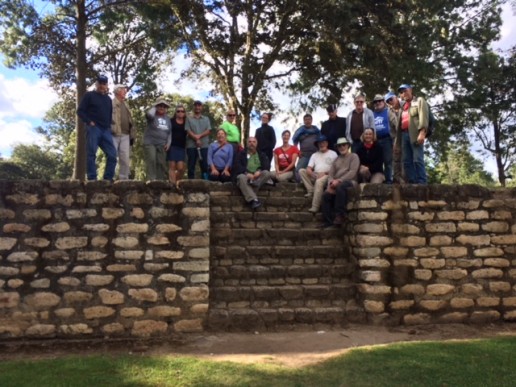Greetings from the Guatemala Habitat for Humanity Team
Submitted by Elizabeth Skarshaug
Eighteen members of the Guatemala Habitat for Humanity Team arrived in Guatemala City on November 3, 2017 to work for one week building clean air stoves for ten families. The team also created a secure foundation for a four-room home for an additional family. The Habitat team returned home on November 12, 2017.
Clean air stoves are part of healthy home kits, which include three parts: clean air stoves, a water filtration system, and latrines. Our Habitat team built two clean air stoves per day for the five days we worked. Two teams of four people worked on each of two stoves per day while the other ten team members worked on creating the foundation for a four room home. The eighteen team members rotated to different duties each day in order for us to experience all aspects of the work the Guatemala affiliate wanted us to complete.
We learned from our Guatemala leaders and from the Habitat Guatemala website that exposure to smoke from traditional cook stoves and open fires – the primary means of cooking and heating for nearly three billion people in the developing world – causes more than 4 million premature deaths annually, including over 5,000 deaths in Guatemala every year.
Exposure to smoke from cooking contributes to a range of chronic illnesses and acute health impacts, such as, early childhood pneumonia, emphysema, cataracts, lung cancer, bronchitis, cardiovascular disease, and low birth weight. Women and young children are the most affected, with 1300 children in Guatemala dying annually as a result of acute lower respiratory infections caused by the use of the traditional cook stoves.
In addition, more than 60% of Guatemala’s population relies on wood fuel for their household cooking and heating needs. More efficient stoves and cleaner fuels reduce the time people, usually women and girls, need to spend collecting wood, freeing up time for income generating activities or education.
In addition to building the ten stoves, the Habitat team provided a good deal of work and effort into creating a foundation for a home for one family. The team worked with the Guatemalan masons to dig a foundation, consisting of ditches surrounding the perimeter of the house and surrounding each of the four rooms plus the extension of the bathroom in the back of the house. While some members of the team worked on digging the ditches, other team members worked on building the rebar poles that strengthen the concrete to help make the house more earthquake proof. When these tasks were completed, the team mixed concrete by shoveling a mixture of dirt, dry concrete, and gravel, then adding water. The wet concrete was then shoveled into buckets. A “bucket brigade” moved the concrete to the section of the house the mason desired, so that he could pour the concrete in the needed spot. After the concrete was poured over the long horizontal rebar poles that had been placed in the ditches, the concrete set. The vertical rebar poles had also been set up. On the final work day (Friday), a team of ten people moved an enormous pile of cinder blocks to locations inside the house where the next Habitat team to work on the house will use them to continue to build the walls of the house.
Time for Some Fun!
Because our Habitat team worked Monday through Friday from 8:30 AM to about 4:30 PM each day (we quit early on Friday), we were able to have some fun in the afternoons, evenings, and on each of the weekends we were in Guatemala. On Friday afternoon, we celebrated the completion of our work by having a ceremony and lunch with the families who received the new stoves and/or the new home. The many children were delighted to enjoy a piñata. Engaging and interacting with the families and children had been a rewarding experience throughout the week for both the Habitat team and the families. We were building relationships and memories that would outlast the days of our visit.
Earlier in the week, we had toured Antigua, a beautiful city, surrounded by active volcanoes. We saw Spanish colonial buildings and beautiful churches. Later in the week, we toured the impressive Mayan ruins at Iximche, near Tecpan, which was where we were working. On Saturday, November 11, 2017, we took a one hour boat trip on Lake Atitlan, a beautiful body of water in a massive volcanic crater in Guatemala’s southwestern highlands. This lake is known for its Mayan villages and its many surrounding active volcanoes. At the end of the boat trip, we arrived at the village of San Juan La Laguna. Here we viewed a demonstration of the art of hand spun cotton at Casa Flor Ixcaco. We learned that age old techniques are used to create threads from cotton grown in the local mountains. The women weave the threads into beautiful products in their own homes. They then sell them at a women’s coop, receiving 80 % of the profit. This provides the women with a sustainable income.
Each morning and evening we had devotions and a time to reflect on the day’s events. We were grateful and appreciative of the work we were able to complete, and for the families we were able to meet. We also had a private church service after breakfast at our hotel on Sunday, November 4, 2017, let by Pastor Glenn Petersen. All in all, this trip was a fulfilling experience!
The Habitat Team, led by Gary and Linda Petersen, included Steve Cox, Jessica Cox, Loren Donahue, Lisa Espinosa, Oscar Espinosa, Mike Farley, Don Haueisen, Gordon Henry, Melissa Henry, Bill Klancke, Carol Petersen, Glenn Petersen, Elizabeth Skarshaug, Tom Roberts, Bruce Wilcox, and Judy Bickenbach.

